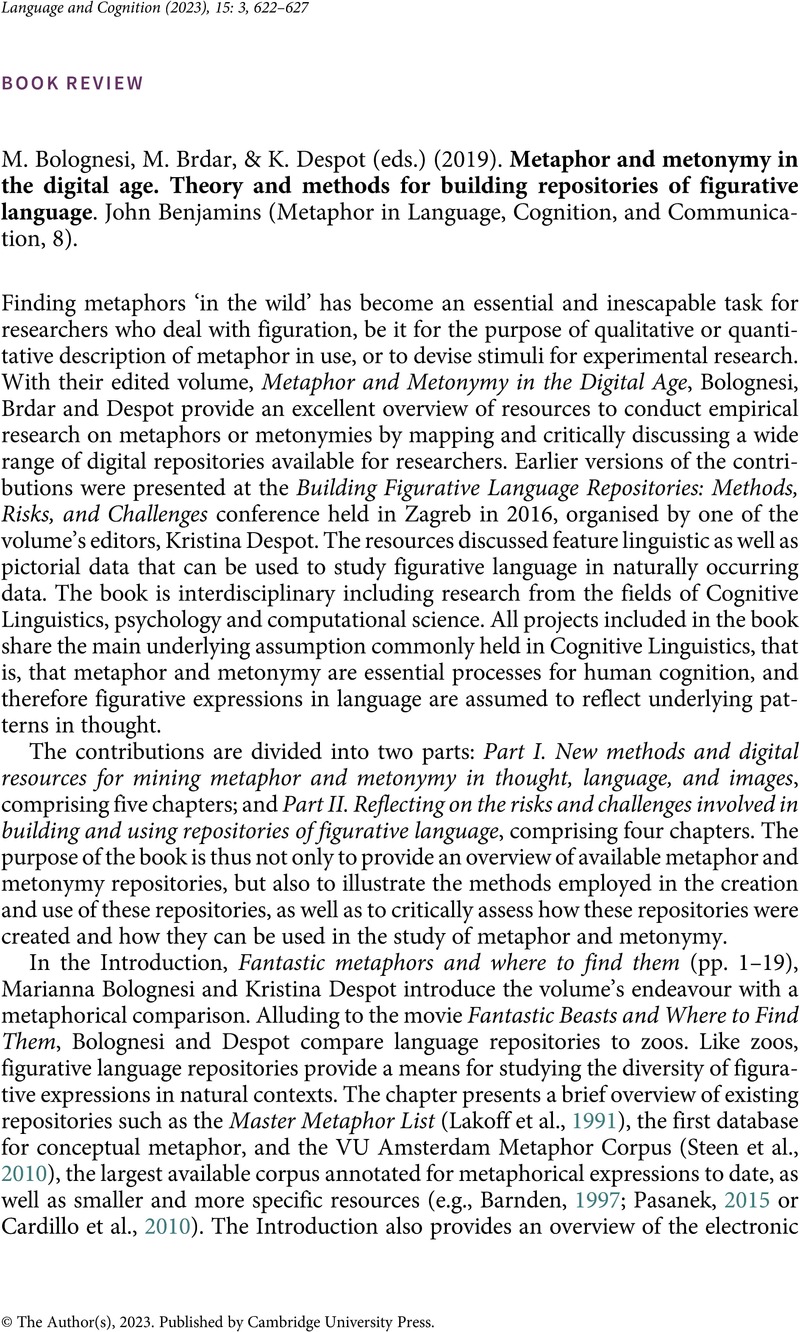No CrossRef data available.
Article contents
M. Bolognesi, M. Brdar, & K. Despot (eds.) (2019). Metaphor and metonymy in the digital age. Theory and methods for building repositories of figurative language. John Benjamins (Metaphor in Language, Cognition, and Communication, 8).
Review products
M. Bolognesi, M. Brdar, & K. Despot (eds.) (2019). Metaphor and metonymy in the digital age. Theory and methods for building repositories of figurative language. John Benjamins (Metaphor in Language, Cognition, and Communication, 8).
Published online by Cambridge University Press: 05 April 2023
Abstract
An abstract is not available for this content so a preview has been provided. Please use the Get access link above for information on how to access this content.

- Type
- Book Review
- Information
- Copyright
- © The Author(s), 2023. Published by Cambridge University Press
References
Barnden, J. A. (1997). Consciousness and common-sense metaphors of mind. In O’Nuallain, S., McKevitt, P. & Aogain, E. Mac (Eds.), Two sciences of mind: Readings in cognitive science and consciousness (pp. 311–40). John Benjamins.CrossRefGoogle Scholar
Bolognesi, M., van den Heerik, R., & van den Berg, E. (2018). VisMet 1.0: An online corpus of visual metaphors. In Steen, G. J. (Ed.), Visual metaphor: Structure and process (pp. 89–113). John Benjamins.Google Scholar
Cardillo, E. R., Schmidt, G. L., Kranjec, A., & Chatterjee, A. (2010). Stimulus design is an obstacle course. 560 matched literal and metaphorical sentences for testing neural hypotheses about metaphor. Behaviour Research Methods, 42(3), 651–64.10.3758/BRM.42.3.651CrossRefGoogle ScholarPubMed
Davies, M. (2008). The Corpus of Contemporary American English (COCA): 560 million words, 1990–present. https://www.english-corpora.org/coca/.Google Scholar
Kövecses, Z. (2015). Surprise as a conceptual category. Review of Cognitive Linguistics, 13(2), 270–90.CrossRefGoogle Scholar
Lakoff, G. (1993). The contemporary theory of metaphor. In Ortony, A. (Ed.), Metaphor and thought (2nd ed., pp. 202–51). Cambridge University Press.CrossRefGoogle Scholar
Lakoff, G., Espenson, J., & Schwartz, A. (1991). Master metaphor list, second draft copy. Cognitive Linguistics Group, University of California. http://citeseerx.ist.psu.edu/viewdoc/download?doi=10.1.1.63.8462&rep=rep1&type=pdf.Google Scholar
Mason, Z. J. (2004). CorMet: A computational, corpus-based conventional metpahor extraction system. Computational Linguistics, 30(1), 23–44.CrossRefGoogle Scholar
Pasanek, B. (2015). Metaphors of mind: An eighteenth-century dictionary. Johns Hopkins University Press.CrossRefGoogle Scholar
Steen, G. J., Dorst, A. G., Herrmann, J. B., Kaal, A. A., Krennmayr, T., & Pasma, T. (2010). A method for linguistic metaphor identification: From MIP to MIPVU. John Benjamins.10.1075/celcr.14CrossRefGoogle Scholar
Stefanowitsch, A., & Gries, S. Th. (Eds.). (2006). Corpus-based approaches to metaphor and metonymy. Mouton de Gruyter.10.1515/9783110199895CrossRefGoogle Scholar
Talmy, L. (1988). Force dynamics in language and cognition. Cognitive Science, 12, 49–100.CrossRefGoogle Scholar



